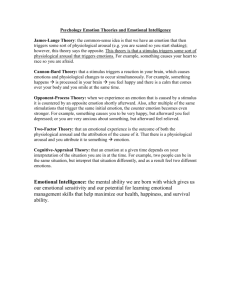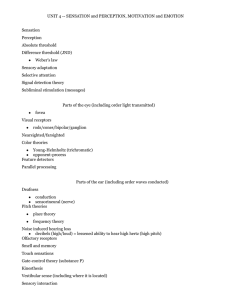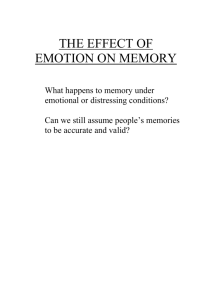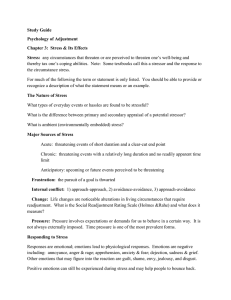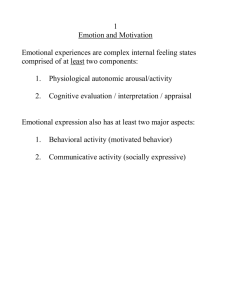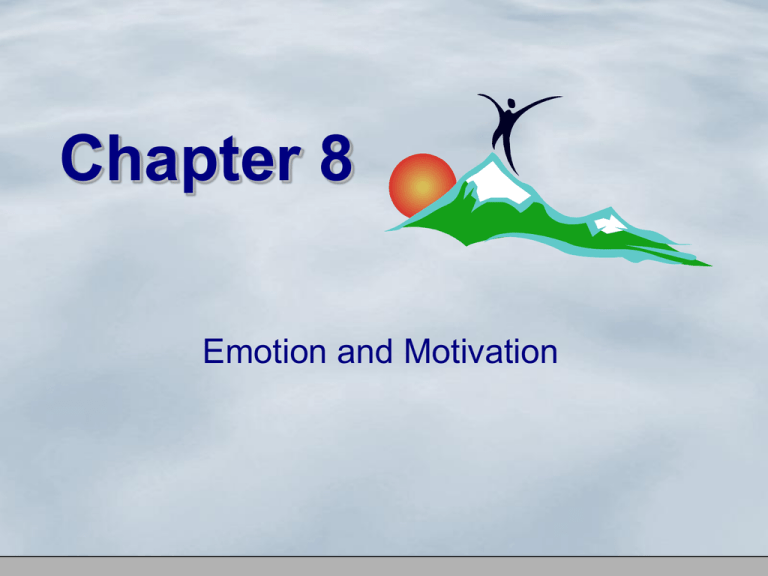
Chapter 8
Emotion and Motivation
What Is Emotion?
Emotion –
A four-part process consisting of
physiological arousal, cognitive
interpretation, subjective feelings, and
behavioral expression
What Do Our Emotions
Do For Us?
Emotions have evolved to
help us respond to important
situations and to convey our
intentions to others
The Evolution of Emotions
Emotions have survival value and have
been shaped by natural selection
Individuals vary tremendously in emotional
responsiveness
Emotions are not entirely programmed by
genetics
Mrs. B. and the 7 Basic Emotions!
Cultural Universals in Emotional Expressions
Can’t remember those?
Then how about this
mnemonic device!
A (anger)
Dog (disgust)
Fears (fear)
His (happiness)
Shadow (surprise)
Cats (contempt)
Squirrels (sadness)
•There are, however,
huge cultural
differences in the
context and intensity of
emotional displays
Cultural Universals in Emotional
Expression
Display rules –
Permissible ways of displaying emotions in a
particular society
The Emotion Wheel
Where Do Our Emotions
Come From?
The discovery of two distinct
brain pathways for emotional
arousal has clarified the
connections among the many
biological structures involved
in emotion and has offered
solutions to many of the longstanding issues in the
psychology of emotion
The Neuroscience of Emotion
The biological mechanisms at work behind
our emotions include:
•
•
•
•
•
The limbic system
The reticular formation
The cerebral cortex
The autonomic nervous system
Hormones
JamesLange
theory
Stimulus:
Snake
Physiological arousal
trembling
increased heart rate
•Named after William James and Carl Lange
•The most basic explanation for emotions.
•They said emotions follow a 3 part
sequence:
1. You perceive the stimulus
2. The stimulus triggers physiological
arousal
3. You label the bodily change as a specific
emotion.
Emotion
fear
So, arousal comes
before emotion;
you feel emotion
because of arousal.
•I feel sad because
I cry
•I am afraid
because I tremble
Copyright © Allyn & Bacon 2007
CannonBard
theory
Stimulus:
Snake
Physiological arousal
trembling
increased heart rate
Emotion
fear
•Named after Walter Cannon and Phillip
Bard
•They disagreed; said that arousal alone
does not cause emotion.
•How do we know if we are afraid, excited,
etc.?
•They said both the arousal and the
cognitive labeling of the emotion occur
simultaneously.
1. You perceive the stimulus
2. The arousal and the emotion occur at the
same time.
So, we see snake
and experience
both increased
heart rate and fear
at the same time.
•Walter Cannon
thought the
thalamus was
responsible for
both the biological
change and the
awareness of the
emotion
Copyright © Allyn & Bacon 2007
•Named after Stanley Schacter and Jerome
Singer
So, emotion is the
• Since arousal is similar for different emotions,
result of the
the important factor is that we THINK about the interaction of
cognitive label that makes the best sense for the
physiological
situation.
arousal and the
•Two part sequence:
cognitive label we
1. You perceive the stimulus
use to describe the
2. Stimulus triggers both arousal and a cognitive situation.
label that makes the best sense for that
arousal. You then label the emotion based on
those TWO FACTORS
Physiological arousal
trembling
Twoincreased heart rate
Emotion
Stimulus:
factor
fear
Snake
Cognitive interpretation
theory
“Snakes scare me!”
Copyright © Allyn & Bacon 2007
Psychological Theories of Emotion
Cognitive appraisal theory –
Theory that individuals decide on an
appropriate emotion following the event
Opponent-process theory –
Theory that emotions have pairs; when
one is triggered the other is suppressed
Arousal, Performance, and the Inverted “U
Describes
the relationship
between
arousal and
The Inverted
“U” Function
– Describes
the
performance; both low and high levels of arousal
relationship between arousal and performance.
produce lower performance than does a moderate
level of arousal
Copyright © Allyn & Bacon 2007
Arousal, Performance, and the
Inverted “U”
Sensation seekers –
Individuals who have a biological need
for higher levels of stimulation than do
other people
How Much Control Do We
Have Over Our Emotions?
Although emotional
responses are not always
consciously regulated, we
can learn to control them
Developing Emotional Intelligence
Emotional intelligence –
Ability to understand and control
emotional responses
Emotional control can be achieved by
learning
Detecting Deception
People can also control their emotions to
deceive
Do “lie detectors” really work?
Polygraph –
Device that records the graphs of many
measures of physical arousal; often
called a “lie detector” really an arousal
detector
Motivation: What Makes Us
Act as We Do?
Motivation takes many
forms, but all involve inferred
mental processes that select
and direct our behavior
Motivation: What Makes Us
Act as We Do?
Motivation –
All processes involved in starting,
directing, and maintaining physical and
psychological activities
How Psychologists Use the Concept
of Motivation
Motivation
• Connects observable behavior to internal
states
• Accounts for variability in behavior
• Explains perseverance despite adversity
• Relates biology to behavior
Types of Motivation
Drive –
Biologically instigated motivation
Motive –
Internal mechanism that directs behavior
(often used to describe motivations that
are learned, rather that biologically
based)
Types of Motivation
Intrinsic motivation –
Desire to engage in an activity for
its own sake
Extrinsic motivation –
Desire to engage in an activity to
achieve an external consequence
(e.g. a reward)
Rewards Can Sometimes Squelch
Motivation
Overjustification –
The process by which extrinsic rewards
can sometimes displace internal
motivation, as when a child receives
money for playing video games
Types of Motivation
Conscious motivation –
Having the desire to engage in an
activity and being aware of the
desire
Unconscious motivation –
Having a desire to engage in an
activity but being consciously
unaware of the desire
Theories of Motivation
Instinct theory –
View that certain behaviors are
determined by innate factors
Fixed-action patterns –
Genetically based behaviors, seen across a
species, that can be set off by a specific
stimulus
Theories of Motivation
Drive theory –
View that a biological need (an
imbalance that threatens survival)
produces drive
Drive Reduction Theory – An action that
reduces the drive
Homeostasis –
The body’s tendency to maintain a
biologically balanced condition
Theories of Motivation
Locus of control –
An individual’s sense of where his or her
life influences originate–internally or
externally
Maslow’s Humanistic Theory
Hierarchy of needs –
The notion that needs
occur in priority order,
with the biological
needs as the most
basic
How Are Achievement,
Hunger, and Sex Alike?
Different?
No single theory accounts
for all forms of motivation,
because each motive
involves its own mix of
biological, mental,
behavioral, and
social/cultural influences
Measuring the Need for Achievement
Projection –
Process by which people attribute their own
unconscious motives to other people or objects
Need for achievement (n Ach) –
Mental state that produces a psychological
motive to excel or reach some goal
A Cross-Cultural Perspective on
Achievement
Individualism –
View that places a high value on
individual achievement and distinction
Collectivism –
View that values group loyalty and pride
over individual distinction
Hunger Motivation
The multiple-systems approach to hunger
Hunger Motivation
The multiple-systems approach to hunger
• Set point –
Refers to the tendency of the body to
maintain a certain level of body fat and body
weight
• Lateral Hypothalamus
• Ventromedial Hypothalamus
• Eating Disorders
• Weight control is a complex
issue with no simple answers
Thirst and Pain
Volumetric thirst –
A drop in extracellular fluid levels
Osmotic thirst –
A drop in intracellular fluid levels
The Scientific Study of Sexuality
Kinsey interviewed 17,000 Americans
concerning their sexual behavior
Masters and Johnson
Sexual response cycle –
Four-stage sequence of arousal, plateau,
orgasm, and resolution occurring in both
men and women
Phases of Human Sexual
Response
Sexual Motivation
Virtually any stimulus that becomes
associated with genital touch and orgasm
can become a conditioned stimulus that
motivates sexual activity
Sexual scripts –
Socially learned ways of responding in
sexual situations
Both learning and genetics affect our
sexual behaviors
The Origins of Sexual Orientation
Sexual orientation –
One’s erotic attraction toward members
of the same sex, the opposite sex, or
both sexes
Motives in Conflict
Approach-approach conflict –
A conflict in which one must choose
between two equally attractive options
Approach-avoidance conflict –
A conflict in which there are both
appealing and negative aspects to the
decision to be made
Motives in Conflict
Avoidance-avoidance conflict –
A conflict in which one must choose
between two equally unattractive options
Multiple approach-avoidance conflict –
A conflict in which one must choose
between options that have both many
attractive and many negative aspects
How and Why Do We
Experience Stress?
The human stress response
to perceived threat activates
thoughts, feelings, behaviors,
and physiological arousal
that normally promote
adaptation and survival
Stress and Stressors
Stress –
A physical and mental response to a
challenging or threatening situation
Stressor –
a stressful stimulus, a condition
demanding adaptation
A Model of Stress
Traumatic Stressors
Traumatic stressor –
a situation that threatens one’s physical
safety, arousing feelings of feel, horror,
or helplessness
Catastrophe
Cohen and Ahearn identified five stages
that occur in the wake of natural
disasters
•
•
•
•
•
Psychic numbness
Automatic action
Communal effort
Letdown
Recovery
Posttraumatic Stress
Posttraumatic stress disorder –
delayed stress reaction in which an
individual involuntarily re-experiences
emotional, cognitive, and behavioral
aspects of past trauma
The Physical Stress Response
Acute stress –
A temporary pattern of arousal caused by
a stressor with a clear onset and offset
Chronic stress –
A continuous state of stressful arousal
persisting over time
The Physical Stress Response
Fight-or-flight response –
A sequence of internal processes that
prepares the organism for struggle or
escape
Tend-and-befriend model –
stress response model proposing that
females are biologically predisposed to
respond to stress by nurturing and
protecting offspring and seeking social
support
The Physical Stress Response
General adaptation syndrome (GAS) –
A pattern of general physical responses
that takes essentially the same form in
responding to any serious chronic
stressor
The General Adaptation Syndrome
Alarm
reaction
Resistance
– the body
– the body seems to adapt
mobilizes it’s
to the
resources to
presence of
cope with a
the stressor
stressor
Level of
normal resistance
Alarm Reaction
Exhaustion
– the body
depletes it’s
resources
Successful Resistance
Illness/death
Resistance
Exhaustion
Stress and the Immune System
Immune system –
bodily organs and responses that protect
the body from foreign substances and
threats
Stress and the Immune System
Psychoneuroimmunology –
Multidisciplinary field that studies the
influence of mental states on the immune
system
Cytokines –
Hormone-like chemicals facilitating
communication between brain and
immune system
Personality and Stress
Type A –
behavior pattern characterized by
intense, angry, competitive, or
perfectionistic responses to challenging
situations
Type B –
behavior pattern characterized
by a relaxed, unstressed
approach to life
Psychological Responses to Stress
Learned helplessness –
Pattern of not responding to noxious
stimuli after an organism learns that its
behavior has no effect
Psychological Responses to Stress
Resilience –
Capacity to adapt, achieve well-being,
and cope with stress, in spite of serious
threats to development
Motivating Yourself
Flow –
An intense focus on an activity,
accompanied by increased creativity and
near-ecstatic feelings
Involves intrinsic motivation


